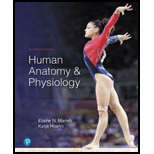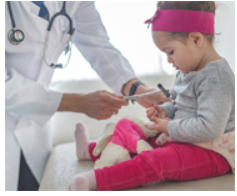
45-Year-Old Female with Motor Nerve Damage
In Chapters 7 and 8, you met Kayla Tanner, who suffered a dislocated right hip in a car accident. Six weeks later, Mrs. Tanner was still unable to walk or run without hip pain, and had weakness in flexion at the knee, excessive foot inversion and plantar flexion, and significant “foot drop” (the inability to dorsiflex the foot).

Electromyography (measurement of muscle electrical activity) and nerve conduction studies (measurement of the speed of nerve impulses) revealed sciatic nerve damage, most likely a result of the nerve being compressed when the hip was dislocated. This large nerve innervates many lower limb muscles. Since her surgery, Mrs. Tanner has been undergoing intense physical therapy and has shown significant improvement.
5. Using descriptions similar to those listed in the question above, explain how you would assess the function of the following muscles:
a. Extensor hallucislongus
b. Fibularis (peroneus) longus
c. Gastrocnemius
Want to see the full answer?
Check out a sample textbook solution
Chapter 10 Solutions
Human Anatomy & Physiology Plus Mastering A&P with Pearson eText -- Access Card Package (11th Edition) (What's New in Anatomy & Physiology)
- bular ligamen A 68-year-old woman comes to the emergency department due to pain in the left uppe arm after a fall from standing height. Medical history is significant for hypothyroidism and hypertension. Physical examination shows bruising of the shoulder. Left arm movement is limited due to pain. Plain radiographs reveal a nondisplaced left hume fracture at the anatomical neck. This patient is at greatest risk for which of the following complications? A. Biceps tendon rupture B. Brachial artery tear C. Humeral head necrosis D. Median nerve injury E. Radial nerve palsyarrow_forwardA 20-year-old man complained that he was unable to raise his right upper limb. He held it limply at his side with his forearm and hand pronated. During questioning by the physician, he stated that he had been thrown from his motorcycle approximately 2 weeks previously and that he had hit his shoulder against a tree. He also recalled that his neck felt sore shortly after the accident. Physical Examination: On examination it was found that the patient was unable to flex, abduct, or laterally rotate his arm. In addition, he lost flexion of the elbow joint. A lack of sensation was detected on the lateral surface of his arm and forearm. The physician requested radiographs of the cervical and pectoral girdle regions. Radiology Report: No fractures are seen in the cervical region, pectoral girdle, and proximal part of the humerus. Diagnosis: Injury of nerves derived from the brachial plexus. Using your anatomical knowledge of the nerve supply to the upper limb, discuss the…arrow_forwardA person came to you with complaint of right hip pain. His age was 45 years. He has a history of right hemiplegia (right sided paralysis) one year back. Manual muscle testing of hip flexors was Grade 4, hip extensors Grade 5 and hip abductors Grade 3. While assessing his gait pattern his left pelvis dropped with every step. His X-ray of hip, knee and ankle showed normal alignments with mild signs of osteoarthritis. 1. What would be the possible diagnosis? 2. Which muscle groups are most likely to be weak that are causing this problem? Writedown the names of muscles. 3. Which test would you perform to confirm your diagnosis?arrow_forward
- The pectoralis major muscle is innervated by the lateral pectoral nerve and axillary nerve. True Falsearrow_forwardThe biceps reflex tests a muscle spindle reflex arc (like the patellar reflex). The biceps brachii is innervated by the musculocutaneous nerve and the triceps brachii is innervated by the radial nerve. When the biceps tendon is tapped with a hammer, action potential generation ___________ in the musculocutaneous nerve and _____________ in the radial nerve. Select one: a. Increases; decreases b. Decreases; increases c. Decreases; decreases d. Increases; increasesarrow_forward**Kindly justify your answers with cited references.arrow_forward
- **Kindly justify your answers with cited references.arrow_forward**Kindly justify your answers with cited references.arrow_forwardA patient demonstrates 0 (absent) DTR of the right triceps brachii, paresthesia over the right third digit and 3/5 strength during resisted elbow extension and wrist flexion testing. What is the most likely diagnosis? What are common types of treatment for this condition?arrow_forward
- Spasticity of the paralyzed muscles in UMN lesions is associated with :-a- inhibition of tendon jerksb- remarkable wasting of the musclec- clonusd- non of the abovearrow_forward18:1V docs.google.com/forms Which of the following has some ?nerve supply from the radial nerve coracobrachialis brachialis long head of biceps short head of biceps Which muscle does not insert in or next to the intertubecular groove of * ?the upper humerus teres major latissimus dorsi pectoralis major pectoralis minor > IIarrow_forward31. ________________ recapitulate the processes of skeletal muscle myogenesis. dentric cells none are correct glial cells satellite cellsarrow_forward
 Medical Terminology for Health Professions, Spira...Health & NutritionISBN:9781305634350Author:Ann Ehrlich, Carol L. Schroeder, Laura Ehrlich, Katrina A. SchroederPublisher:Cengage Learning
Medical Terminology for Health Professions, Spira...Health & NutritionISBN:9781305634350Author:Ann Ehrlich, Carol L. Schroeder, Laura Ehrlich, Katrina A. SchroederPublisher:Cengage Learning- Essentials of Pharmacology for Health ProfessionsNursingISBN:9781305441620Author:WOODROWPublisher:Cengage





